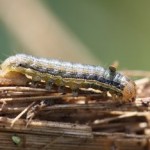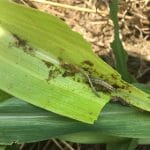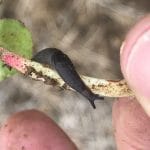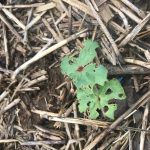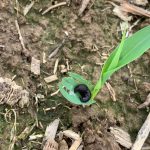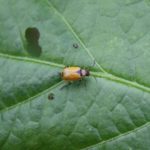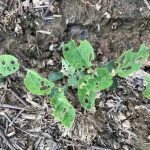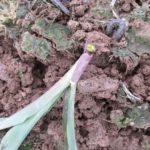Well it’s a start anyhow. Most folks are dodging weather trying to get seed in the ground. With limited crops emerged, it is not too surprising that I’ve not been getting many calls about pest problems. The most frequent calls are listed below, along with some management tips and some photos.
- Armyworm (A.K.A. true armyworm) have been reported at treatment level in a few wheat fields, but this has been hit-or-miss. Premature defoliation can cause yield loss. The threshold is to treat if there are more than 6-8 larvae per square foot and wheat is still in the milk stage. From what I’ve seen, most of our wheat is on the edge of milk and dough, and by next week, even high levels of defoliation will not have much impact on yield in most fields. Always watch for head clipping when high numbers are armyworms are present, although this is even more hit-or-miss than armyworms. If needed, treatment with any labeled pyrethroid insecticide and a mid to high rate should provide good control.
- Armyworm damage is also being reported in corn, mostly where armyworms were present in a cover crop having wheat, oats, and/or cereal rye. It’s a numbers game whether feeding will cause economic damage. Corn can tolerate a lot of leaf feeding, but high populations could pose a threat to small corn. Again, a labeled pyrethroid insecticide should provide good control.
- Calls about slugs have not been as common as I would have thought, but I’m still getting some. I’ve attached some pictures of typical damage. Mysterious feeding in fields with a lot of residue is a good sign of slugs which will generally being hiding when the sun is out. For emerged crops, the feeding is usually worse than it looks, but again, it’s a numbers game and slugs can reduce stands if the stems or roots are fed upon. Cool and wet conditions don’t help. My best management recommendation is to increase your seeding rate in cotton and soybean by 5-10% if slugs are present at fairly high numbers, and don’t plant if it’s too wet to close the seed furrow. Putting out a ladle full beer-soaked oatmeal is several spots, leaving it overnight, and checking the bait first thing in the morning, is a good way to check if you have a few or a lot of slugs present. You can cover it with a pie pan or a shingle to keep it shaded. Finding 1 or 2 slugs on a bait is pretty normal (heads up when you are finding considerably more).
- Don’t be fooled by bean leaf beetles. We often see leaf feeding concentrated in early planted fields if an insecticide seed treatment was not used. This often has little impact on yield, but it can be confused with slug feeding.
- Some cutworms are being reported sporadically throughout the state. Control with pyrethroid insecticide is generally reliable, if needed, but the most important thing is to catch a problem before too much damage as occurred. As with all of these critters, do your best to keep a close eye on crops during the first 14 days after emergence when plants are most susceptible.
- I’ve not had much mention of thrips in cotton, mostly because relatively little cotton is above ground. Based on the thrips forecast model, https://climate.ncsu.edu/cottonTIP, it appears we are at low risk for significant thrips pressure in Tennessee for a little while. This tool can help decide if a foliar insecticide application is justified. However, you should back this up with personal observation, particularly when conditions result in slow emergence and seedling development. Remember, the best time to make an insecticide application for thrips is early (1-2 true leaf stage). Thus, the decision to treat is often based mostly on climate and growing conditions.
Some Resources for You:

